
The fashionably retro Mini Cooper hatchback received an update earlier this year that brought a new automatic gearbox, a new infotainment fit-out and some endearingly kitsch cosmetic enhancements that see the Union Jack literally stamped all over a car that’s already quite overtly British.
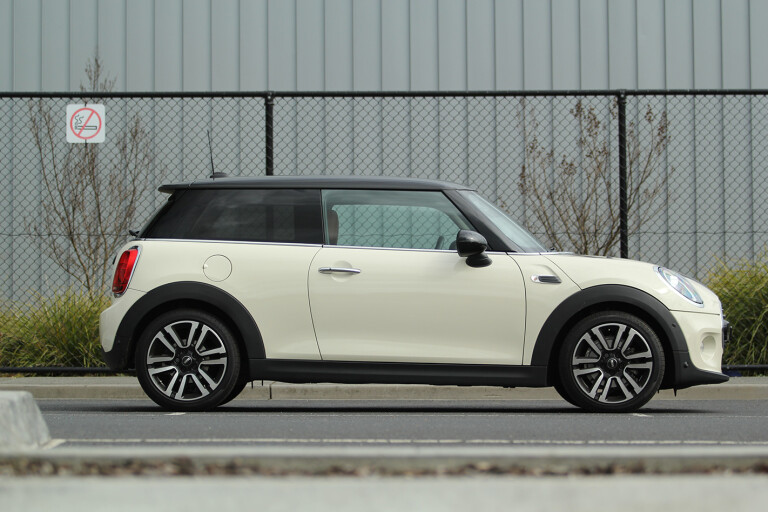
Do these changes enhance the core car? We spent a week at the wheel of a base model Cooper three-door automatic to find out.
VALUE
With a $32,400 retail price before on-road costs, the auto-equipped version of the base Cooper three-door hatch is not what you’d describe as a bargain buy.
But if you consider its positioning as a premium vehicle in the light car class, it’s about par for the segment. Its natural rival in this country is the Audi A1, which retails at $30,500 for the similarly-specified 1.4TFSI Sport grade. The Mini makes more power and torque, has a more sophisticated suspension set up and boasts sat-nav as standard, but the A1 counters with five-door practicality by default. The Cooper can be had as a five-door too, but at a price premium of $1250 over the three-door’s retail.
Another rival is the similarly retro Abarth 595, which aligns quite closely with the Cooper on price, configuration, power and torque. It is, however, significantly older and pitched at a more performance-focused buyer.
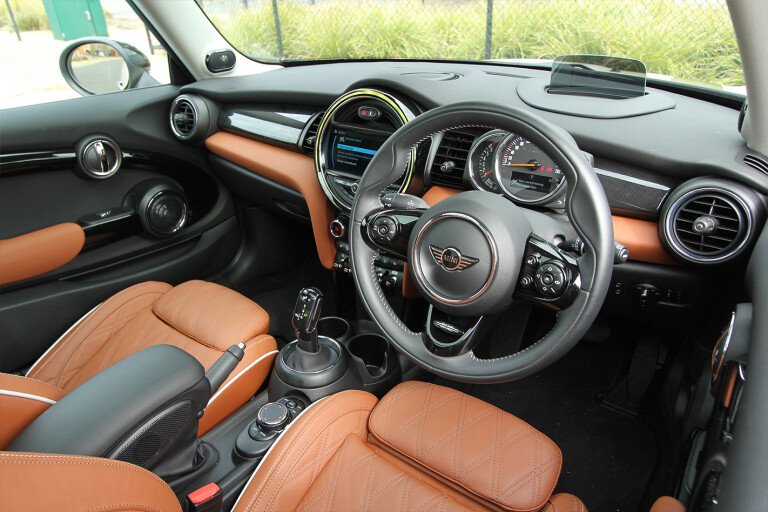
The Cooper we tested was far from standard-issue, however, which hurt its 'value for money' quotient. Equipped with thirteen options and option packages, our car had an as-tested retail price of $47,450. No matter how you cut it, that’s an eye-watering amount for a three-door light hatch. If price is important to you, do your best to steer clear of the options list.
Running costs should at least be affordable, with a claimed fuel consumption of 5.3L/100km on the combined cycle. Our as-tested economy of 6.2L/100km over the course of a week of mostly urban commuting was certainly reasonable.
STANDARD FEATURES
As standard, the Mini Cooper comes with a fairly basic specification that includes manual air conditioning, cloth upholstery, 16-inch alloys, Bluetooth, rear parking sensors, Bluetooth, dusk-sensing headlamps, rain-sensing wipers, power windows and a reversing camera.
A 6.5-inch colour touchscreen is the central interface for the car’s infotainment, and can also be controlled via a rotary dial behind the gear selector. If you’ve ever used BMW’s excellent and intuitive iDrive system, you’ll quickly become accustomed to Mini’s infotainment interface – no surprise, given BMW is Mini’s parent company. For the 2018 update, there’s also Apple CarPlay smartphone mirroring and additional internet-enabled services to play around with.

However, the feature list pretty much ends there. Even dual-zone climate control, something that you would expect to be standard on a $29K light car, doesn’t become available until you start spending more money on options – and our car had plenty of those. Here’s a list of what our tester came with:
- 17-inch alloy wheels
- Bonnet stripes
- Chrome interior accents
- Sports seats
- Chester Malt brown leather upholstery and cabin trim
- Sports leather steering wheel
- Backlit piano black dash trim
- Chili package (LED headlamps, front armrest, dual-zone climate control, drive mode selector, front foglamps, interior ambient lighting)
- Convenience package (keyless entry, front parking sensors, park assist, power folding mirrors, self-dimming mirrors)
- Climate package (panoramic glass sunroof, front seat heating, UV-cut glass)
- Multimedia Pro package (8.8-inch infotainment screen, voice recognition, head-up display, Harman Kardon 12-speaker audio, wireless phone charging)
You can see how the as-tested price breached the $47K mark. You do at least get plenty of glitz for your extra spend. Configurable ambient lighting, backlit dashboard trim and a plethora of cabin colour combinations are yours for the taking, and it’s this ability to customise that’s central to the Mini Cooper’s appeal.
SIZE

With a diminutive footprint that measures 1.7 metres wide and just 3.8 metres long, the Cooper three-door is tiny. Those dimensions put it firmly in the light car class, and slightly under the Audi A1 that’s its primary rival. The Fiat/Abarth 500 is smaller again, but for a two-door hatch that’s best suited to carrying two adults most of the time, the Mini Cooper is about as small as you’ll probably want to go.
Luggage space is, predictably, quite limited, though the repositionable - or completely removable - boot floor offers either double-decker stowage or enough room (just) for a single large suitcase. Flip the 50/50 split rear seats forward and you get more cargo space, though we still wouldn’t recommend using the Cooper for transporting something like a flat-pack bookcase.
SAFETY
Standard safety equipment includes stability control, traction control, ABS, brake assist and six airbags, however autonomous emergency braking (a feature fast becoming commonplace in mainstream light cars) is not included in the base Cooper.
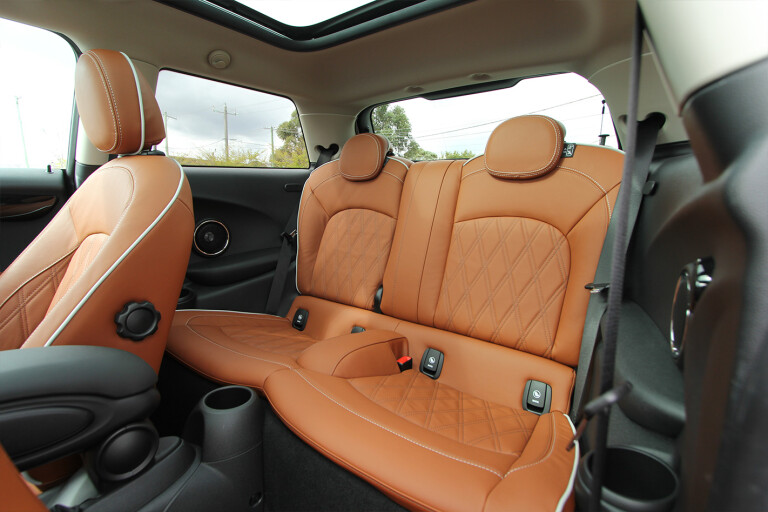
You only get that feature if you opt for the Control package, Active package or Chili package, putting the Cooper at odds with many other vehicles in its size or price class. Furthermore, the current-generation Cooper was assessed by ANCAP in 2014 and given a four-out-of-five star crash safety rating – another demerit in a market where five-star ratings are the norm.
COMFORT
There’s some ergonomic iffyness courtesy of the centre armrest’s high position, but that’s a cost option and you arguably won’t miss it if you don’t tick that particular box.
Otherwise, front-seat comfort is generally excellent. The Cooper may be small, but the range of adjustment in its front seats and steering column mean people of a broad range of body types will easily find a comfortable posture. The sports seats of our test car might be a $1700 option, but they’re supportive, attractive and arguably worth the extra spend.
Materials and build quality are superb, and the cabin ambience is one of near-premiumness. The influence of BMW is evident, and in a good way. Unfortunately, the rear seats are the Cooper’s Achilles heel: with nearly no legroom with the front seats occupied, you’re better off paying a little more for the five-door Cooper if you regularly carry more than one passenger.
Ride quality is the source of another complaint. With the 17-inch wheels and run-flat tyres of our test car, the Cooper had a ride that was more brittle than desirable for an urban runabout. We’d be forgiving of that if it were a performance-oriented model, like the Cooper S or Cooper JCW, but if you’re looking in the Cooper’s direction for daily-driver duty we’d recommend sticking with the (rather attractive) standard-issue five-spoke 16-inch alloys.

ON THE ROAD
Great driving dynamics has always been a central part of the Mini ethos, and even the base model Cooper delivers on that front. The steering provides a solid, connected feel with the front wheels yet still feels fluid and natural, while the multi-link rear suspension delivers glued-down handling. Body control is taut, perhaps too taut for those who just want to zip around town. If road quality is poor in your neighbourhood, perhaps take an extensive test drive to ensure Cooper’s suspension is pliant enough for your tastes.
But one thing that’s new for the 2018 model year is a fresh new automatic transmission. Gone is the old conventional automatic, and in its place is a seven-speed dual-clutch auto.
Transmissions of this type aren’t normally known for their low-speed driveability, with jerky engagement at low speeds, such as when parking or dealing with heavy stop-start traffic. Thankfully, the Mini’s dual-clutch has no such problems. It’s smooth when taking off from a standstill, yet crisp and decisive when in motion. Exactly how an automatic should be.
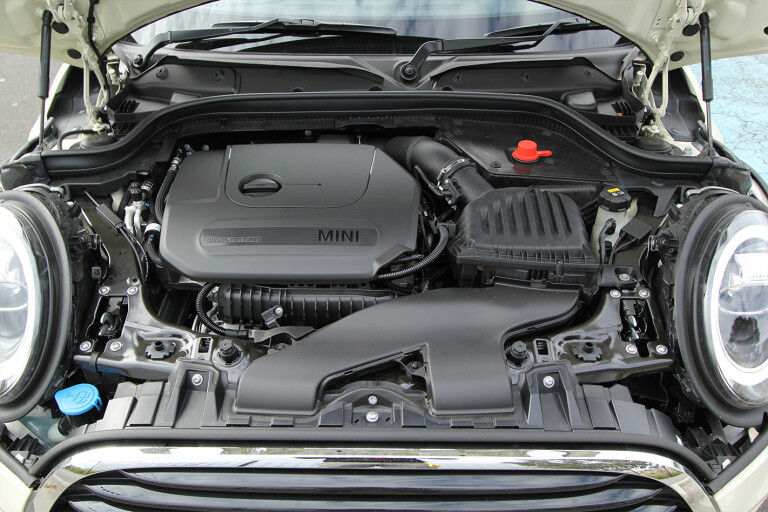
In the base Cooper it’s paired with a 1.5-litre turbocharged petrol inline three, which makes a healthy 100kW and 220Nm and accelerates to 100km/h in a quite respectable 7.8 seconds. It’s a likeable engine, but it suffers from a lot of vibration when the auto engine start-stop system is working. A minor quibble, but one that may annoy in the long-term.
VERDICT
It’s difficult to make a definitive judgement on the base Cooper from this particular car, given its particularly heavy coat of options and the fact that many of them alter the car’s fundamental character.
It certainly feels premium, we’ll give it that, but so it should given the vehicle we tested was nudging $50K before on-road costs were factored in. Stripped of all of the options to put it at its base $29,900 retail price, there’s a risk that the Cooper may feel a touch bare-bones. Options, then, become almost mandatory, but unless your wallet is especially thick we’d urge restraint when selecting which options you’d like.
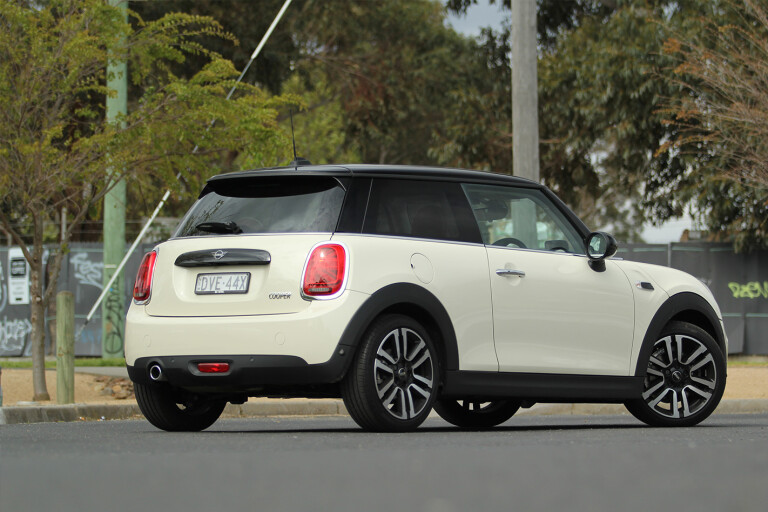
On the other side of the coin, there are few cars in this size class that boast the kind of personality that the Mini Cooper does. It’s seemingly endless customisability and outstanding handling are its calling cards, and for those that shop with their heart those are likely reason enough to consider one.
COMMENTS